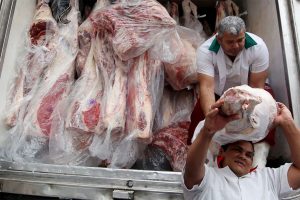THE PHILIPPINES joins a select group of growing economies that will drive expanding meat consumption over the next decade or so, the Food and Agriculture Organization (FAO) and the Organisation for Economic Cooperation and Development (OECD) said.
In their agricultural outlook for 2025-2034, the FAO and the OECD said global poultry, sheep meat, beef, and pork consumption are projected to grow 21%, 16%, 13%, and 5%, respectively, by 2034.
“Due to rapid consumption and income growth, 45% of global growth will be located in upper middle-income countries,” it said, noting that meat consumption growth, aside from China and India because of their substantial populations, is expected to be greatest in the Philippines, Brazil, Indonesia, the US, and Vietnam.
Global meat production was estimated to have risen by 1.3% to 365 million metric tons (MMT) in 2024, driven by poultry, “with beef output increases,” it said. Pig and sheep meat production remained stable.
Significant growth in meat production occurred in Australia, Brazil, the European Union, and the US.
Brazil, the Philippines’ largest source of meat imports, recorded the “most significant expansion” across all major meat categories, “driven by strong global demand, supported by higher net returns due to a favorable exchange rate and lower feed costs as well as continued disease-free status.”
Global meat exports recovered in 2024, rising 2% to 40.2 MMT after two years of decline, due in large part to expanded imports by the Philippines, the United Arab Emirates, and Mexico.
The report also said the Philippines, Brazil, Egypt, Mexico, and the US, will account for a significant segment of global poultry consumption, which is expected to hit 173 MMT on a ready-to-cook basis by 2034.
By that year, poultry meat is expected to account for 45% of the protein consumed from all meat sources, it said.
The increase in poultry consumption in the last decade was driven by China, India, Indonesia, Pakistan and Vietnam.
“The global increase in protein from poultry meat consumption as a share of total protein from meat has been the main feature of the growth in meat consumption for decades, and this trend is expected to continue,” the report found.
It cited poultry’s low cost and favorable nutritional profile, specifically a high protein-to-fat ratio compared to other meats.
“Environmental considerations also contribute to the shift towards poultry meat, as the production of red meat is more resource-intensive and leads to higher greenhouse gas emissions,” it added. “Poultry is, therefore, more appealing to sustainability-conscious consumers.”
The FAO said in most high-income countries, which accounted for 35% of global meat consumption but only 17% of the world’s population in 2024, growth in per capita meat consumption will continue to slow, with consumers shifting preferences — “often reducing meats like beef and pork in favor of poultry.”
“Higher-income consumers are increasingly attentive to the animal welfare, environmental, and health attributes of food, which in some places is leading to stagnating or even declining per capita meat consumption,” it added.
Philippine meat imports in the first quarter rose to 344.59 million kilograms (kg), from 273.64 million a year earlier.
Pork accounted for 53.2% or 70.45 million kg of all meat entering the country in the first quarter, against 128.5 million a year earlier.
It was followed by chicken at 111.36 million kg or 32.3% of first-quarter meat imports.
Beef imports in the first quarter rose 24.2% to 43.9 million kg or 12.7% of all meat imports. — Kyle Aristophere T. Atienza

